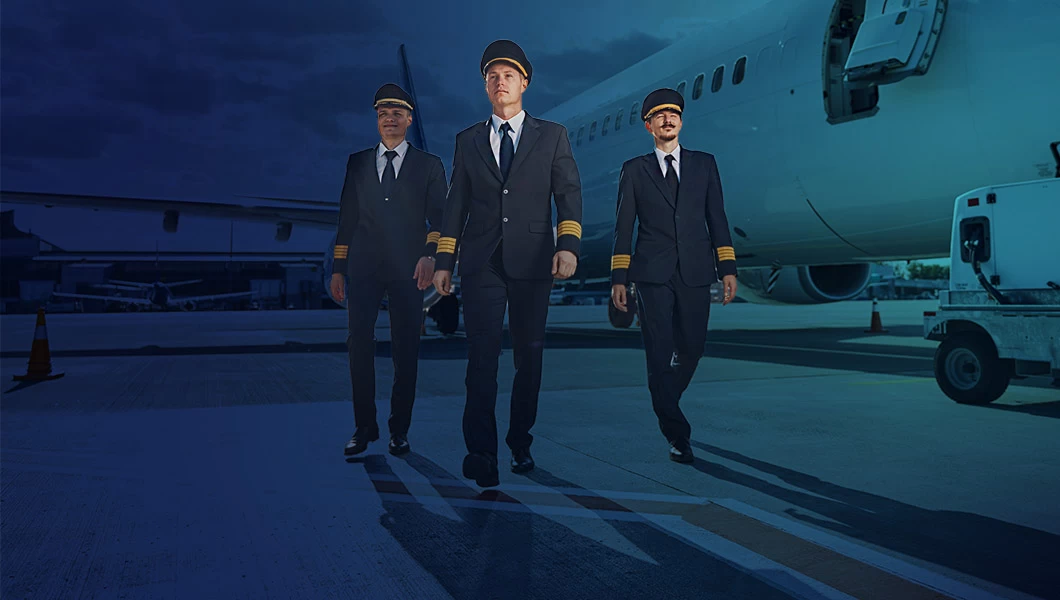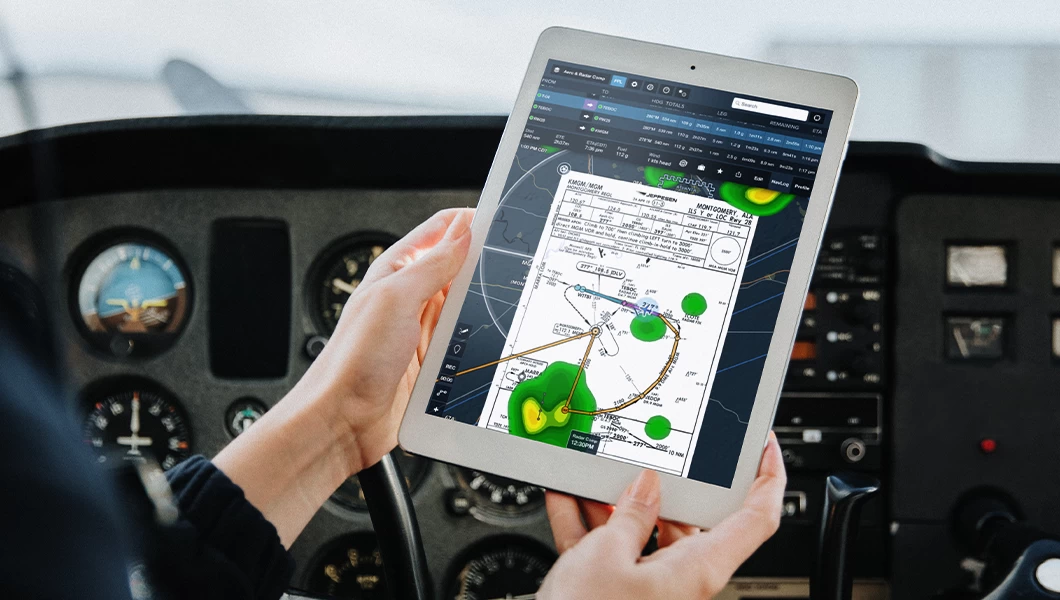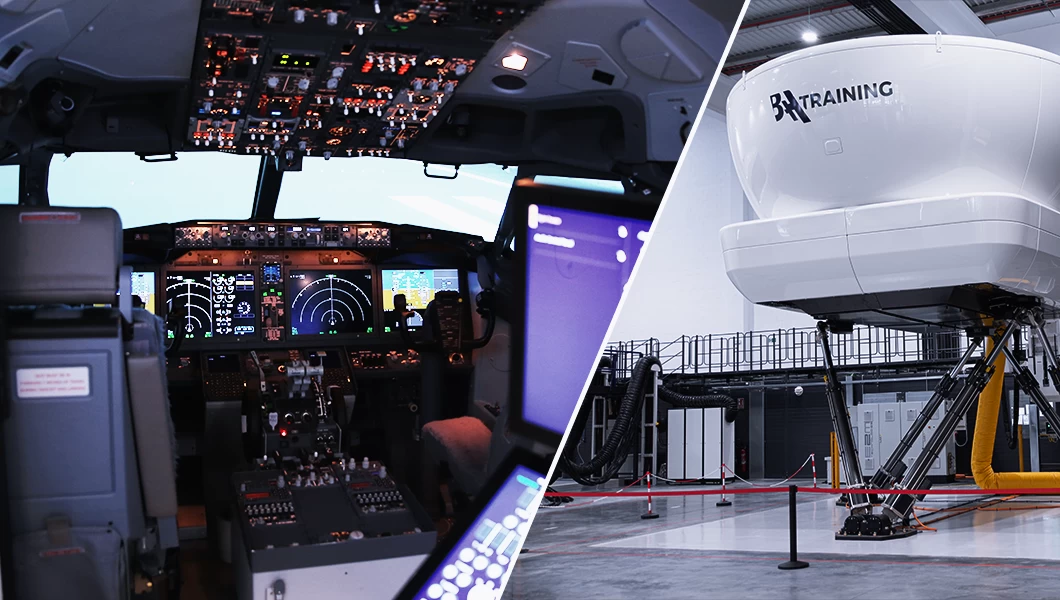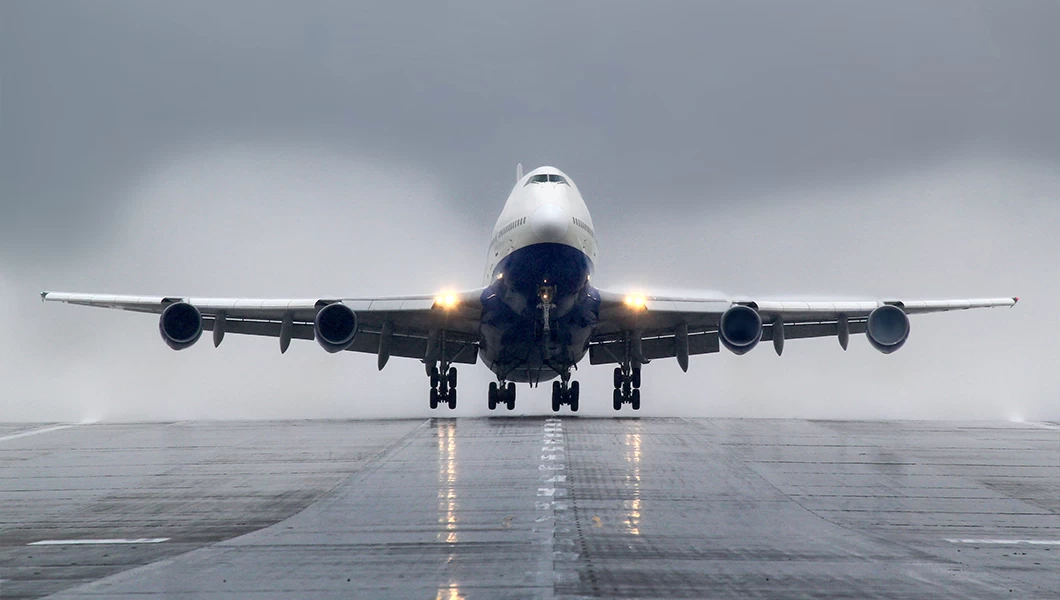VFR and IFR: Main Difference
VFR and IFR, which stand for Visual Flight Rules and Instrument Flight Rules, respectively, represent two interrelated frameworks governing pilot navigation in the skies. VFR offers the simplicity and freedom of navigating by sight, ideal in clear weather. In contrast, IFR is the choice for flying primarily by instruments, essential in poor visibility conditions, including fog, rain, or night-time operations.
Navigating a VFR flight
So what does it mean to navigate the aircraft by sight or, in other words, visually? It is when pilots use recognizable landmarks, like rivers or cities, as well as pilotage skills for navigation to technology such as GPS.
Flying under VFR conditions can be compared to going on a leisurely drive, giving pilots the freedom to choose their own route and altitude within certain airspace limitations. Unlike IFR flying, VFR pilots do not have to maintain constant communication with air traffic control and strictly adhere to a flight plan. Thus, they have more flexibility (except for controlled airspaces that may require them to do so).
Needless to say, they get many more opportunities for activities such as sightseeing or simply enjoying clear skies by flying in circles.

VFR Pilot Restrictions
Although VFR offers pilots a great deal of freedom, it is important to obey the limitations.
First and foremost, it should be noted that VFR flights can only be performed in visual meteorological conditions (VMC). VMC refers to weather conditions in which pilots have sufficient visibility and cloud clearance to operate the aircraft without relying on instruments. The table below shows the VFR minimums.
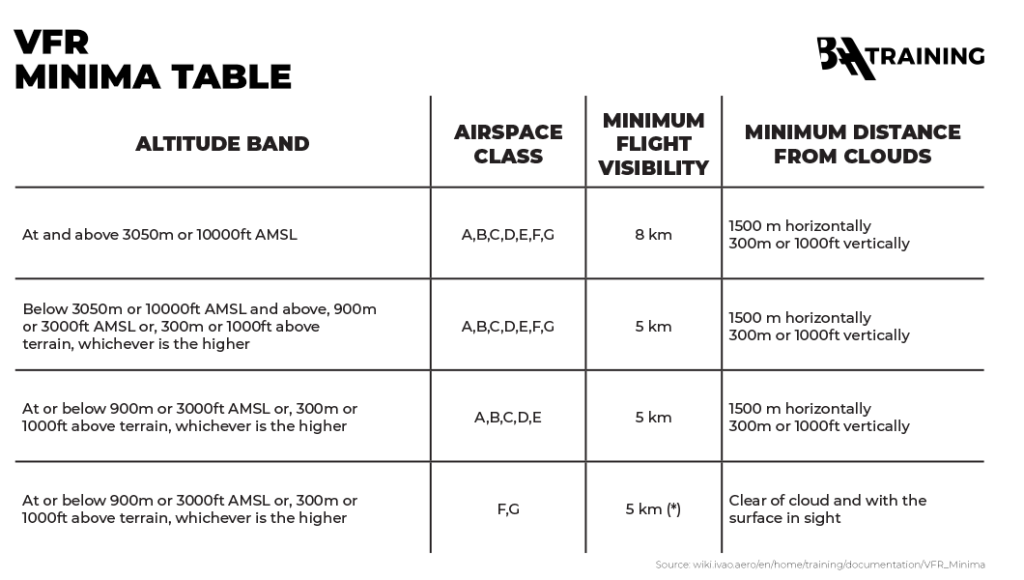
Remember — stick to VFR if you’re flying VFR! If you spot an enticing cloud that seems tempting to fly through, keep in mind that another pilot might have the same idea coming from the opposite direction.
In addition, the obligations for VFR flying include:
- Maintaining visual contact with any designated aircraft
- Being cautious regarding wake turbulence avoidance measures
- Preparing contingency plans beforehand when expecting deteriorating weather conditions
It highlights how essential it is for VFR pilots’ readiness combined with vigilance while operating an aircraft within this mode.
Navigating an IFR Flight
IFR is necessary when visibility becomes limited and outside references cannot be relied upon. It is specifically designed for conditions like fog, rain, or nighttime flights. While operating an IFR flight in Visual Meteorological Conditions (VMC) is possible, they are primarily intended for Instrument Meteorological Conditions (IMC), such as adverse weather. Also, unlike VFR, you can perform IFR flights in controlled airspace Class A (the most restrictive).
To fly an aircraft under IFR regulations, pilots must have two-way radio communication and proper navigation equipment suitable for their planned route, usually using ground-based navigational aids like VOR or GPS technology. Essential instruments include a gyroscopic rate-of-turn indicator, slip-skid indicator, a sensitive altimeter that adjusts with barometric pressure, and a clock displaying hours, minutes, and seconds along with an attitude indicator.

Filing the IFR Flight Plan
Operating an IFR flight requires pilots to possess an Instrument Rating certification and file a detailed IFR flight plan beforehand. An IFR flight plan is a crucially important and carefully planned route for all aspects of the flight, including coordination with air traffic controllers. To submit an IFR flight plan, pilots typically use approved electronic systems or platforms designated by the relevant aviation authorities. This electronic filing ensures efficient communication of the flight plan details to the appropriate Air Traffic Control (ATC) facilities.
Once the IFR flight plan is submitted, the next step involves requesting clearance using standard communication protocols. It is worth keeping in mind that weather changes can happen abruptly, from clear skies to thunderstorms. Therefore, attention should be paid closely to weather reports before flying.
Commercial Pilot Has to Fly Under IFR
In commercial aviation, the majority of an airline pilot’s responsibilities, especially during en-route portions, fall under IFR. The use of IFR ensures a high level of safety and allows for consistent operations regardless of the prevailing weather conditions. The tragic incident described below underscores the importance of adhering to the mandated IFR (Instrument Flight Rules) requirements. It serves as a critical reminder that deviating from the prescribed process can result in grievous consequences.
On Sunday, September 19, 1976, Turkish Airlines Flight 452 crashed en route from Istanbul Atatürk Airport (IST) to Antalya Airport (AYT). The aircraft, a less than two-year-old Boeing 727-200 with the registration TC-JBH, went down near Isparta in western Turkey, taking the lives of all 154 passengers and crew. Experts analyzing the cockpit voice recorder revealed that the pilots were flying VFR instead of IFR. The plane’s First Officer mistook a large dark area ahead for the Mediterranean Sea, which, in fact, was the Taurus Mountains. He also mistakenly identified lights on a highway leading into Isparta as the runway lights of Antalya Airport (AYT).
Similar ARTICLES

Why Pilots Prefer IFR Over VFR and Vice Versa?
The decision to fly under VFR or IFR requires careful consideration of several factors, apart from your possessed rating and weather conditions.
For many pilots, the continuous communication and supervision provided by air traffic control make IFR a preferred choice, especially at night or in unfavorable weather conditions. This option also allows instrument-rated pilots to navigate more efficiently through busy and complex airspace, similar to those in major European metropolitan areas like London, Paris, or Frankfurt. Navigating through congested regions is streamlined, addressing concerns about restricted zones and the need for multiple clearances in European airspace.
In contrast, pilots often opt for VFR flights because they offer greater freedom in selecting flight paths and altitudes, as well as the opportunity to enjoy hands-on visual experiences throughout each journey, enriching the overall flying experience. In addition,VFR doesn’t require as much equipment as you have to take care of when flying IFR; it tends to be more cost-effective, especially for pilots flying small airplanes for leisure or hobby purposes. Last but not least, flying with VFR requires a higher level of pilot skill in terms of situational awareness and spatial orientation, which ultimately translates into better overall flying abilities.
Flight Training Pathways: From VFR to IFR Rating
To obtain an Instrument Flight Rules (IFR) rating, pilots must undergo additional training beyond the requirements for Visual Flight Rules (VFR) and hold a private pilot license. The rigorous instruction, delivered by a certified flight instructor, focuses on instrument flying and enables pilots to operate under IFR conditions.
If you seek the freedom to navigate through clouds and avoid trip cancellations due to unfavorable weather conditions, pursue an IFR rating (on single-engine or multi-engine aircraft). This approach will allow you to increase the number of flight hours in your logbook efficiently.
Your PILOT CAREER
starts with a first click
Furthermore, the IFR rating is essential for those aspiring to fly commercial aircraft in the future, just like completing an MCC course and obtaining a Type Rating.
Summary
Piloting aircraft requires mastery of both Visual Flight Rules (VFR) and Instrument Flight Rules (IFR). VFR relies on visual references for navigation, while IFR uses instruments and coordination with air traffic control to navigate through varying weather conditions.
Experienced pilots and student aviators must understand the complexities of these flight rules to operate safely within shared airspace. They are responsible for being knowledgeable about the nuances and making informed decisions that promote safety, efficiency, and smooth operation during flights.
Frequently Asked Questions
What is the difference between IFR and VFR?
The primary distinction between IFR and VFR is that while VFR regulations pertain to visual flying, IFR deals with utilizing aircraft instruments for navigation during flight.
IFR vs VFR: which one is harder?
While flying under instrument flight rules (IFR) presents a greater challenge than flying under visual flight rules (VFR), pilots who have obtained this rating possess the skills and knowledge necessary to handle both types of flying. Whether navigating through difficult weather conditions or relying on visual cues, these pilots are well-equipped for all situations.
Do airline pilots always fly IFR (Instrument Flight Rules)?
It is standard practice for airline pilots to adhere to regulations and company protocols by flying under IFR conditions.
Do private jets fly IFR or VFR?
Private jets have the ability to operate under both instrument flight rules (IFR) and visual flight rules (VFR). The choice between VFR and IFR is often based on weather conditions, regulations, and the pilot’s qualifications and equipment.
What are the limitations of VFR (Visual Flight Rules) flying?
When flying VFR, it’s essential to maintain a clear vision of terrain and other aircraft, comply with airspace restrictions, meet visibility requirements, and adhere to specific cloud clearance rules.







